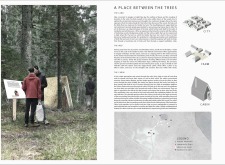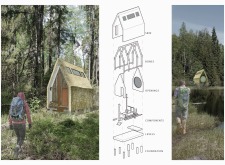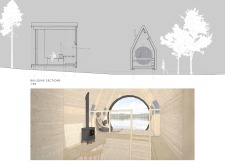5 key facts about this project
The structure is characterized by its simple, functional design, which is sensitive to the unique ecological characteristics of the site. The cabin employs materials such as wood for its primary structure, straw bales for insulation, metal for supporting elements, and glass for maximizing natural light and integrating views of the forest. Together, these materials dissolve the boundaries between indoor and outdoor environments, creating a seamless transition that reflects the surrounding landscape.
Innovative Integration of Nature
What distinguishes this project from similar architectural endeavors is its methodology of integrating natural elements into the design process. The architectural design not only focuses on aesthetics but also on sustainability, utilizing eco-friendly materials and passive heating and cooling techniques. The open-plan layout allows for flexible use of space, accommodating activities ranging from solitary meditation to community gatherings.
The strategic placement of window openings is essential for enhancing visual connections with the external scenery, thus fostering an immersive experience in nature. Additional features include an elevated meditation platform that serves as a focal point, inviting occupants to engage deeply with their surroundings. This element underscores the project's commitment to promoting mindfulness, urging visitors to connect both with themselves and the environment around them.
Functional Educational Spaces
The design incorporates educational spaces that align with the project’s mission to enhance environmental awareness. These areas are dedicated to workshops and educational programs that highlight the significance of local ecosystems. The architectural layout encourages exploration, with pathways that direct movement and facilitate interactions, reinforcing the sense of community among users.
Overall, "A Place Between the Trees" exemplifies a thoughtful approach to architecture that prioritizes harmony with nature, sustainability, and community connectivity. Each aspect of the design is a deliberate choice that contributes to the overall function and experience of the retreat.
For further insights into the project, it is recommended to explore the architectural plans, architectural sections, and architectural ideas presented. Understanding the specific design elements will provide a deeper appreciation of how this project effectively merges architecture and nature in a unique manner.


























